#Siem Reap Volunteer Work
Explore tagged Tumblr posts
Note
Hi! What organization did you go through for the Cambodia trip? I’ve always wanted to do something like that but worried that it’s a scam - did you pay for your own airfare and all?
hello!
i went through Sustainable Health Empowerment which is affiliated with the UCLA club Medical Experience through Service in Healthcare (MESH)
And well I went on this trip with a lot of skepticism myself, so the worry that it’s a scam is totally understood. In the end though, we served a LOT of people! We worked with Khmer medical and dental teams (dental team actually did free extractions and fillings! and medical team gave out common medicines and did a lot of consultation/hospital referral for those who needed it)
Personally I worked on the Vision team and we screened our service recipients for reading glasses (most of them are older persons) and honestly it was pretty cool how some of them didn’t even realize that they could read newspapers better by just wearing glasses, and that reaction to seeing clearer is so good lol they’re like WOW WHAT IS THIS ITS SO CLEAR
But yeah we did pay for our own airfare and we had to pay contribution for hospitality and food, but during the trip they really took good care of us. We stayed at NICE hotels (Sun&Moon Urban Hotel in Phnom Penh is awesome and safe, and Lotus Blanc in Siem Reap was PARIDISE OMF)
Anyways in the end it’s really up to you to make the time worth it as well! If you work hard, your give the recipients quality healthcare and services, and you personally gain a very meaningful experience. It’s quite literally the definition of ‘you get what you give’!!
I’d recommend volunteering abroad to pre-health students if the opportunity is available and affordable. I’m really glad I went :’)
19 notes
·
View notes
Photo

We are a family-run Khmer business with a deep passion for our country and its people. Our mission is for you to discover the real Cambodia.
Our handcrafted day trips and tour packages introduce you to local Khmer people, Cambodia’s impressive ancient history and the tragedy of its modern history. We reward you with rich cultural experiences, adventure, fun and stunning landscapes.
We are a Cambodian business supporting Cambodian people and we are strong advocates for sustainable, low impact, environmentally friendly tours and supporting local people.
The team at Smart Sinn Travel works hard to ensure you leave the Kingdom of Wonder with more than just memories but with a heart-felt attachment to the country and the Khmer people.
Smart Sinn Travel is a business with a conscience and we are dedicated to empowering Cambodian people living in poverty. We donate 10% of profits from Smart Sinn Travel to Siem Reap NGO, Volunteer Building Cambodia to build homes for those in need.
1 note
·
View note
Link
In Cambodia, we are building the ROV Community School that provides free education to children living in rural communities and also helping poor and homeless peoples during volunteers programs
#Donate to Reach Out Volunteers Charity#Siem Reap Volunteer Work#Volunteer Siem Reap#Animal Volunteer Opportunities#Elephant Sanctuary Thailand Volunteer#Paid Volunteer Work Abroad#volunteer Holidays#Vacation with a Purpose Missions#Volunteer Abroad Programs
0 notes
Text
Motivation
You’re back. Let’s dive a little deeper into why we’re here.
Short story time: I started my career in public accounting / consulting where in the earlier years Corporate Social Responsibility (CSR) was mostly about people getting together 1 day out of the year, putting on corporate logo t-shirts, and going to a soup kitchen or a food bank to put their hands to good use and snap some feel good photographs. It felt rather disingenuous. Like it was more about us, and our company, than about the people whose lives we were supposed to be impacting. I felt like there had to be something more to this, something where I could actually offer my professional skills pro bono. Like Doctors Without Borders, but for accountants. I spent the next few years exploring ways to offer my accounting / tax / finance skills pro bono and got involved in low income tax assistance clinics and after school financial literacy education programs (for high schoolers). These were still small scale or one off projects so I started my search on the internet for something bigger than me. Through some Google searching I found Accounting for International Development (AfID), an organisation based in London that pairs accountants / finance professionals looking to offer their services pro bono with NGOs/non-profits/community organisations (partner organisations) that are seeking such professionals. AfID pairs accountants / finance professionals with partner organisations that already have established accounting / finance teams and are seeking to supplement their skills or receive assistance with a specific project. I am lucky that CSR has made huge advancements since the beginning of my career and many companies (such as the one I work for) now recognise that employees like to give back to their time in their own unique ways, and support us in financial and other ways to make that happen.
Motive: I like to quote the TV show classic “Bones” (American crime drama based on the life of a real physical anthropologist and her FBI beau): “What do you want to be when you grow up?” (cute question considering their both middle aged professionals), response “I hope I’m someone who gave more than they took.”
Can I be volunteering my time in my home country? Yes, though I currently live in the Netherlands and don’t speak Dutch yet so my opportunities for volunteering are quite limited. But in addition to my educational degree in accounting I also have a degree in cultural anthropology. I seek out experiencing other cultures so I can always grow my understanding of the diverse world we live in.
Wednesday I set off for Siem Reap, Cambodia where I will be partnering with Women’s Resource Center (WRC) for 4 weeks. This looks like an amazing group of women and I’m excited to get to know more of them in person. I was excited to partner with WRC particularly because their mission is one that is important to me. If we can improve accounting and finance processes in a way that improves programs offered to the community members that WRC serves, then I’ve served my purpose.
www.wrccambodia.org/home/
www.afid.org.uk
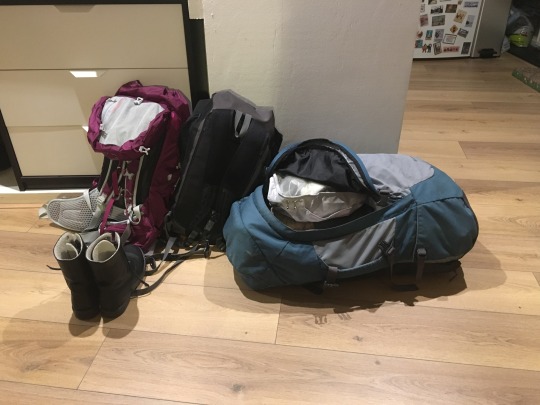
1 note
·
View note
Link
April is hot in Cambodia, with temperatures regularly hitting the mid-30s. And in the tourist town of Siem Reap, performers at New Cambodia Artists (NCA), the country’s first contemporary dance company, lay down in their studio as they wait for the midday heat to pass.
The power cut doesn’t help. Several industrial fans stand silent and suffering in the oppressive heat. But soon the lights come on, the fans start to whir and rehearsals begin again. The four female dancers glide across the wooden floor, hands and feet disrupting the blazing light pouring through open double doors.
Their improvisation dreams up ancient soldiers and heavenly courtesans like those carved into the stone walls of Angkor Wat’s temples. Then it shifts, powering through centuries, as the dancers move as if riding motorbikes through a modernising city.
The team at NCA are on the keen edge of modern dance in Cambodia. They lobbied the Ministry of Arts and Culture for a year to be certified to perform contemporary dance at public venues. Their main challenge was that certification for contemporary dance didn’t then exist.
“At first, we were only permitted to perform classical dance at public sites like the [nearby] Angkor Wat temples,” says company director Srey Neung. “But now we are the first company to be certified and able to perform contemporary dance in public.”
The Angkor Wat temples and surrounding archaeological park attracted 2.5 million visitors in 2017 – which means that performing for tourists there is a good source of revenue for local dance troupes. But despite their certificate, the Apsara Authority, which manages the park, banned them in 2016. (“Apsara” refers to a traditional Khmer dance dating to the 7th century and featuring more than 1,500 hand gestures.)
“We were blacklisted for not being Cambodian enough,” says dancer Khun Sreynoch. “And they said our costumes were too sexy. They are supposed to be under the ministry, but the ministry hasn’t done anything.”
“Their attitude is very frustrating,” she adds. “Art is supposed to be creative – and if the performers and choreographers are Cambodian, then it’s Cambodian enough.”
Apsara Authority spokesman Long Kosal refused to comment directly on the case, saying only: “Any dance company is welcome to submit a request to perform within the park.”
But the spokesman did address his agency’s concerns over supposed impropriety of troupes’ costumes: “The dance troupes who currently perform at venues within the park, like Kravan temple, are a good example of what is an appropriate kind of performance.” He said that traditional costumes should cover performers’ shoulders and that skirts should hang below the knee.
The delicate romps and highly stylised gestures of Apsara performers at places like Kravan temple could not be more different from NCA’s provocative compositions.
If anything, the women at NCA have become even more determined to continue with their fresh style. Sreynoch is currently developing a solo performance using red stilettoes.
“It’s my favourite dance,” she says. “I use Apsara dance moves to show I’m Cambodian, but the red shoes show that I am an independent woman.” In the climax of the dance, she discards the shoes in a whirl of limbs and pirouettes.
“I throw the shoes away in the end to show I am strong enough as I am; it’s about the development of character,” she says. “The conservatives say we cannot touch traditional movements and cannot create anything new. If I use high heels to perform classical dance moves, they will say I’m destroying the culture.”
This kind of conflict is new in Cambodia, where choreographer Sophiline Cheam Shapiro is informally credited with developing the first contemporary Cambodian dance in 2000 – an interpretation of Shakespeare’s Othellothat referenced the horrors of the Khmer Rouge.
“When I told my uncle, Chheng Phon – an important guru of Cambodian dance – that I wanted to bring two classical traditions together, he said I was very daring to touch such a precious heritage,” Shapiro told Southeast Asia Globe. “I told him I must still try.”
Although modern dance has thrived in Cambodia for two decades, she said, “modern artists can still be discouraged or attacked when they debut their performances.”
“Most of the time the government has been supportive of me,” she added. “When we apply to dance at official venues, they tend to allow us… The arts and culture officials have the responsibility to take care of the art, and I respect that.”
Hab Touch, director-general of the Ministry of Culture and Fine Arts, sat at a huge wooden table in front of framed certificates awarding Cambodian Apsara Dance a place on the Representative List of the Unesco Intangible Cultural Heritage of Humanity.
“We want contemporary art, but we want it to be Cambodian contemporary art,” he said. “We have to define what is ours, and I worry that some artists take on a Western style without keeping the Cambodian tradition.”
“Lack of infrastructure is [another] problem modern artists face,” Touch said. “We are concerned that we have little space for artists to show their work, though we try our best.”
Bob Ruijzendaal, a Dutch theatre director who founded NCA before passing ownership to Srey Neung and the dancers, threw up his hands in exasperation when asked about the infrastructure problem. “Everywhere you go, there is a concrete floor and there is mostly a red carpet on it and you cannot dance on it. Everybody says, ‘Yeah, we have a carpet!’ and we [just] cannot dance on that.”
The lack of artistic space, combined with indifference from local people, has left NCA’s performers feeling isolated. “As well as managing NCA, I’m studying business administration at university,” says Srey Neung. “My classmates think I’m very strange doing this work. They are only interested in following each other, and if we try to encourage them to see our performances, they don’t want to come.”
“My mum and sister support me a lot,” NCA dancer Kong Soengva says. “My father says that I ought to stop and get a real job, but I point out that NCA pays for school, travel – and I earn money from our performances, so I think he is getting more used to the idea.”
NCA’s main income is from performing at their studio and hotels in Siem Reap, plus the occasional show in Phnom Penh. The dancers earn about $100 a month. The company also pays for their schooling, food and insurance.
“We need some extra funding to support the volunteer choreographers who come from Europe to help [with] training,” says Srey Neung. “Right now, we don’t have anything for them, and we want to at least cover their expenses while they stay in Cambodia.”
As the day finishes, Srey Neung’s sister arrives with her baby and the dancers take a break to play with the one-year-old. “We want young Cambodians to recognise what we do,” says Srey Neung, bouncing the child on her hip. “Then they can come and see us and support us.”
29 notes
·
View notes
Photo
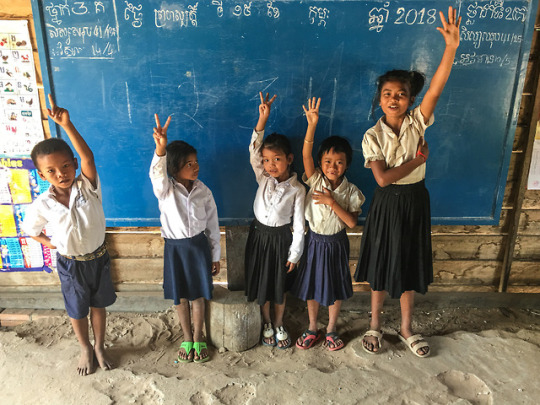
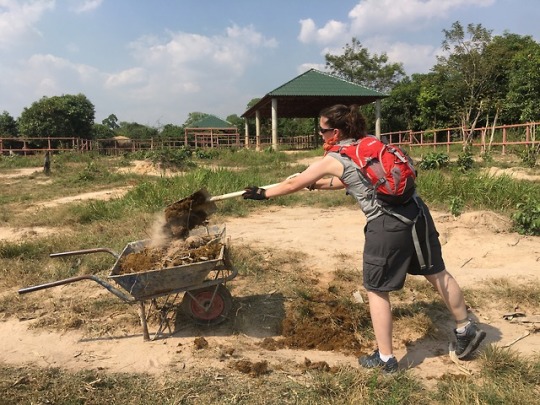
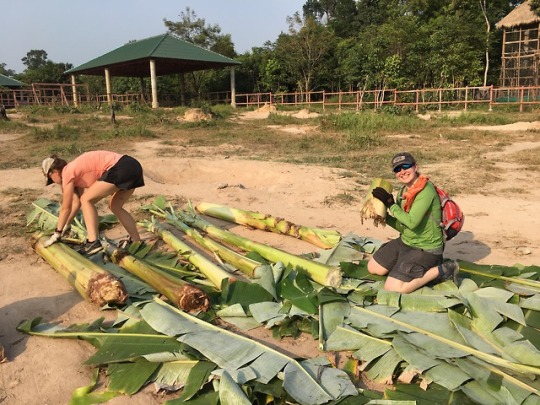

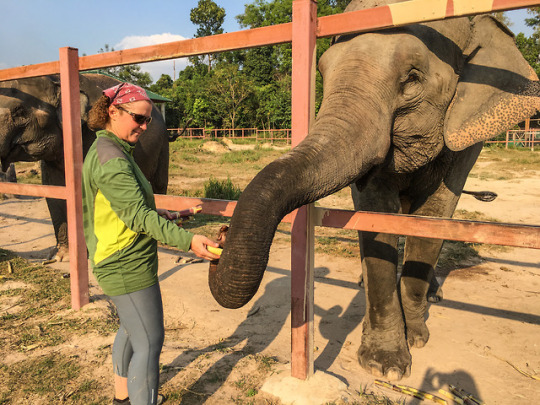

From Alaska to Asia: a vacation spent volunteering
Sweat rolled down our foreheads and into our eyes as the tiniest of flies swarmed around our faces. Rivers of dirt and dung ran down our arms, drying into the creases of our elbows in the hundred-degree heat of a Cambodian jungle. How did we get here?
Just over one year ago, the two of us had never even met. Vanessa Rathbun, a BLM Alaska Visual Information Specialist and lifelong Alaska resident, and I, a Public Affairs Specialist and nomadic military spouse, found ourselves working cube-by-cube in Alaska in early 2017. We quickly discovered that we enjoyed several common interests, from outdoor adventures, art, technology, Broadway musicals, volunteering, to travel and more. Almost exactly one year later, we checked in for the first of four flights to carry us from Anchorage, Alaska, to Siem Reap, Cambodia, via Seattle, Seoul and Bangkok. To add to this exhaustive itinerary, it should be noted that three of the four flights were redeyes and layover times ranged from three- to twenty-three hours in length.
We took advantage of a nearly 24-hour layover in Seoul, South Korea, and charged through a whirlwind of activities to fill the time and explore the city before continuing the final legs into Cambodia. Finally arriving in Siem Reap, we marked just another short layover in our journey. With only one afternoon to acclimate, we reset our wardrobes from “winter in Alaska” to “summer in Southeast Asia,” accounting for the almost 100-degree temperature difference. Early the next morning, we hopped into a pickup truck for a 90-minute bumpy drive to Ânlóng Vêng, home of the Cambodia Wildlife Sanctuary. The Sanctuary is a one-million-acre animal and environmental conservation project committed to rescuing wildlife, preserving the jungle and providing sustainable community employment. Staff and volunteers work here to protect elephants freed from the performance and trekking industries and to care for an assortment of monkeys, dogs, leopard cats, and various fowl.
Our living arrangements at the Sanctuary were basic, but very comfortable. We slept in simple wooden huts with thatched roofs. We woke each morning at sunrise, our alarm clock – the sounds of elephants trumpeting while leaving their night shelters for their daily jungle walks. Hearty vegan meals were sourced from the permaculture gardens onsite, as well as from local village farms in the Ânlóng Vêng province.
Each morning after breakfast, we grabbed our shovels and rakes to join the “pooper scooper” crew to clean the elephant night shelters. After working up our first sweat of the day, we moved from one Sanctuary duty to another, handling everything from working in the gardens, planting and watering new sugarcane fields, harvesting bananas, digging fencepost holes, clearing fire breaks, and more. As each day ended, we prepared food baskets for the returning elephants. The simplest and best reward for a hard day’s work was the time we spent feeding freshly chopped sugarcane and bananas to each elephant before joining the staff for our own evening meals. An even more appreciated reward at the end of each day was a cold bucket shower to rinse off those dried veins of sweat, dirt and dung.
Midway through the week, we traveled to the local village school to deliver much-needed school supplies, play games and teach the students a variety of basic English language skills. We both felt this was a major highlight of our Cambodian volunteer week!
This was my third volunteer visit to the Sanctuary. Watching the children of the nearby village learn and grow makes me want to come back year after year.
On our final day at the Sanctuary, we spent a glorious few hours walking with the elephants along their jungle paths. Each of us carried brightly colored scarves, blessed by local Buddhist monks to tie around the largest and most mature trees. Marking the trees in this manner discourages illegal logging as the village community now views the trees as sacred. Walking with the elephants, hearing their gentle steps behind us and watching them enjoy their new lives of freedom was an experience neither of us will ever forget.
As our week ended, we returned to Siem Reap to transition from volunteers to vacationers! For three extraordinary days, we visited the 12th and 13th century-built temples of Angkor Wat and Ta Prohm along with the Phnom Kulen mountain range and waterfalls. Late afternoons and early evenings we spent traveling by tuk tuk to meet like-minded volunteer friends in the city working for organizations that help feed families, care for street dogs and educate the local children of Siem Reap.
“I had no idea a volunteer experience would also give me such an up close and personal opportunity to interact with these gentle giants,” said Vanessa.
Volunteering together gave Vanessa and me several memorable moments to look back on for years to come. More importantly, we came to know one another better as friends and strengthened our work relationship immeasurably. We hope anyone reading this will be inspired to consider spending their downtime doing something uplifting!
Story by Lisa Gleason, Public Affairs Specialist. Photos by Lisa Gleason, Public Affairs Specialist and Vanessa Rathbun, Visual Information Specialist.
During #NationalVolunteerMonth, we celebrate the selfless work of our volunteers. The BLM values the thousands of volunteers who offer their time, skills and service to help care for the nation’s natural and cultural resources. Volunteers contribute to many BLM program areas, including recreation, wild horses and burros, cultural and historical resources and environmental education and interpretation. Our volunteers work with us to be good neighbors in the communities we serve.
76 notes
·
View notes
Text
A dental student’s month in Cambodia

“I am a final year dentistry student and have recently returned from an incredible month spent in Cambodia. Our dental team consisted of seven students, volunteering with the organisation One-2-One. We spent four weeks in Phnom Penh and its surrounding provinces. After ten hours on two planes, I met my team whom had flown separately from their respective placement sites all across Australia.

The first week was spent at the University of Puthisastra where we saw numerous orphans and NGO (non-governmental organisation) patients. Luckily, we still had the luxury of air conditioning, dental chairs and occasionally Cambodian dental students whom acted as our translators. It was a unique and rewarding first week as we adjusted to the humid climate and food!

In the following three weeks we ventured outside our comfort zones into the country-side. Our coordinator had advised us that the accommodation and even food would not be the same as Phnom Penh, the capital. Likewise, this consisted of: cold showers, electricity shut off between 8am and 5pm, mostly vegetarian meals, and of course rooms accompanied with a handful of mosquitoes and other dead insects…. We quickly forgot about all of this when we were greeted by children waving and awaiting our arrival at the school! While the Cambodian team was setting up our mobile clinic, we spent that time befriending all the cute students that came running out of their classrooms.




At the provinces, we operated in conditions that we weren’t previously exposed to. This included: limited materials and tools, no suction equipment, air conditioning or dental chairs. Hence we had to be very flexible and find new techniques of working. I learnt a variety of new extraction techniques from the Cambodian dentists and placed fillings quickly before the material hardened in the hot weather. Most importantly, I became increasingly aware of the importance of ergonomics during extractions, as I began to get back pain from bending over on the dental “chairs” that were not adjustable. After a short week, it was a sad goodbye to the friendly group of kids. I hope to return someday and see a decline in tooth decay and pain.

Another week was spent at a provincial prison- it was the first time for all of us stepping foot into one. We were informed of the strict rules by the prison guards- no taking photos of the prisoners or asking what crimes they committed. There were 700 male and 40 female prisoners. At first, it was intimidating as you could feel the eyes of all the prisoners as you walked from the entrance into our little room, which had a small wired fence around to separate us from the prisoners. It wasn’t uncommon to have an audience watching you operate- just a few metres away- as they sat in lines adjacent to the fence. Here, we performed almost full days of adult extractions. To add to our exhaustion was the lack of air conditioning and occasional sun peeking through the fence. After this week, we all got a few well-deserved massages!

On another quick note, we were lucky to be able to travel and relax on the weekends. These weekend trips included: Phnom Penh, Siem Reap and Kampot. Highlights were: temple runs at Oudong and Siem Reap, tasting world famous Kampot pepper and relaxing by the poolside.


Overall, it was an extremely enjoyable and rewarding journey, one that I’ll always have very fond memories of. By pushing through all that we’re familiar with and working and living in new conditions, I believe that we’re able to appreciate what we take for granted back in Australia. It is inspiring to see children that have the largest smiles even through so much hardship. What a truly heart-warming month to be able to volunteer and make a difference in their oral health, whilst also improving our clinical skills. I would like to thank Dr Felicity Croker and One-2-One for their support and this wonderful opportunity.”
- Madeleine La, 5th Year JCU Dentistry Student

1 note
·
View note
Text
Most powerful passionate students in Cambodia~ Small giving pledge BLOG No.3 ~
Hello world!
Finally, the temperature here reached to 40 degrees.
40 degrees?? How crazy it is!!!!!
To tell the truth, when it comes to only summer temperature, Nagoya or Gifu is the worst place to live..
I know, there are so many other great benefits, so it's not fear to judge cities with the only temperature though.
Today I want to introduce the amazing organization and social enterprise, CRST and Project Y.
100% guarantee, if you go to SiemReap and wanna find the best smile ever in this world, just drop by Project Y to grab your ice cream!!
OK, please just let me explain about CRST and ProjectY briefly.

WHO ARE CRST?
Founded in 2011 by the Palti family from Melbourne, Australia, the Cambodia Rural Students Trust (CRST) is a Non-Government Organisation (NGO) registered with the Cambodian Interior Ministry. The NGO is managed on the ground in Cambodia by their senior students, who are mentored in managing an organization by a group of Australian business volunteers.
WHO ARE Project Y?
Project Y Frozen Yogurt is an Education Social Enterprise set up by the Cambodia Rural School Trust (CRST) in Siem Reap, Cambodia.
This store is owned by CRST and operated by the students of CRST - a not-for-profit NGO with the mission of Breaking the Poverty Cycle Through Education. All profits remain in the NGO to sponsor their students High School & University education, as well as community projects.
You already know how unique they are.
Yes, this NGO and social enterprise are run by local students from the Rural area in Cambodia!!!
This point is truly what makes them so unique.
What else more …
- 100% of donations are used for education, mentoring and community projects.
- NGO sponsors their student's education, health and dental care, life skill courses and monthly living allowances
- All students contribute back to the community with regular volunteer commitment for up to 2 hours daily. The entire NGO student family also volunteers once a month on a rural community project.
How I met them
Back in winter of 2015, when I just moved to Cambodia, I just happened to meet a Cambodia nice guy Visith.
He invited me to join their community service, and that was my first touch point to encounter them.
What I was most amazed was all of them were really enjoying their community service.
All of them came from poor families, and actually to enter this NGO, they need to pass the exam and interview which means that not everyone can join this NGO.
They knew that they were lucky, of course, they divorced their selves and got c chance by themselves, so they have hearts to help their community.
I was so impressed by them because they run NGO, manage social enterprise and coordinate volunteer program regularly.
Could I do that when I was a university student?
Hell no!!
I was just a "student" who went to uni just to practice dance.lol
(Just in case, my major was marketing)
What I most like is they have good hearts.
They know that if they work and study hard, they can pass another chance for next generations which is super great.
From the bottom of the heart, I really look up to them.
Oh, I need to tell one more thing.
You know why they are so nice and passionate and helpful??
The answer is the founder, Aviv.
This Austrian guy is so so so passionate.
To describe him, I don't think here is not enough, so maybe next time.
Of course, students of CRST themselves are passionate, but the most passionate person is him.
He leads Cambodian students in a good way.
Luckily, I became a coach to teach soccer to them.
We spent a lot of time together, so it was so sad to say goodbye to them.
I donated 5% of my last February’s salary.
So excited to come back to SiemReap next year with my parents and see them.
Cheers!!
1 note
·
View note
Text
Teaching English, Cambodia
Those who can't do, teach... that couldn't be farther from the truth. Tati and I wanted to find a way to give back to the Cambodia people so volunteered in a Cambodian English school.
Some people are probably laughing right now, rightfully so. I was never good at English. Spelling and grammar were my Achilles heal throughout school, so when I was tossed in the fire that morning I was terrified.
Our day began with a bike ride from our homestay in Siem Reap to the school 3-miles away. Once we cleared the main area of town we found ourselves on unpaved dirt roads, bouncing up and down on our bikes. This wasn't a side street, this was a heavily traveled road by motorbikes and large trucks alike. This put into perspective the village community we were serving.
When we arrived we were giving a brief introduction to the school and showed the classroom we would be teaching in. Up to this point, I had exchanged 2 emails with Sieng, the school director and from our correspondence, figured we would be helpers.
The bell rang and the kids filled our classroom. Sieng was in the classroom with us and spoke a few words to the students in Khmer, then boom! He said, the kids want to learn about 'fruits' that was it. No instructions, no help, no idea what level English the students had, the only thing he gave us was whiteboard markers.
We taught 3 classes back to back. It was a struggle, I couldn't tell if the kids were bored from repetitiveness or bored because they didn't know these words yet. Either way, when lunch arrived I was ready to be done. I was physically and mentally drained.
Tati and I biked away to get lunch. The entire bike ride I thought about not going back... but Tati was not going to let me give up that easy. She put together a few lesson ideas and we peddled back to school.
We had some time before the next class started so I took the opportunity to speak with Sieng, I was curious about the school.
We learned the school was founded in 2006 to help the local village children learn English. Knowing English provides huge career opportunities yet the public school don't teach English. Elma School has had its ups and downs and closed twice due to lack of funds. Sieng was a teacher but in 2014 he became the director and has been committed to helping grow the school. They invite volunteers and volunteer groups to help teach and work on development projects important to the longevity of the school. Hearing this gave me a recharged sense of purpose and I was excited for our next classes.
Tati and had organized some interactive games that included drawing, speaking, basic conversations and some new vocabulary. The next classes went well and we were both relieved when they were over. To end the day we sat in on a local teachers class. At the end he asked if we wanted to go over one of the activities in the classes workbook, I said sure, and taught the last lesson on describing what people are wearing.

The experience was very unique and in the end, even more rewarding. It was refreshing to get out of my comfort zone and engage in an activity focused on giving back to the local community. Tati and I were happy (and exhausted) we hope our efforts and donation to the school help this great organization!
3 notes
·
View notes
Text
News From The Jungle
November 12 2020
Siem Reap Cambodia
COVID SITUATION
Covid came here, like everywhere else, about 9 months ago. Being a small country we were all concerned, once we realized it was for real, that it would quickly spread to every village in the country. That didn’t happen. The government jumped on it quickly, locking down, restricting travel and asking everyone to wear a mask.
It worked. Out of 219 countries in the world, Cambodia is 188th, with only 301 reported cases and no deaths. Almost all the cases here came from people traveling back to the country from elsewhere. Community transmission has been virtually nil.
Last week we had the “November 3 Incident”. The Minister of Foreign Affairs from Hungary visited Cambodia. He met with the PM, his wife, The Minister of Sports, people from 2 provincial education departments, one karate club, six public schools and 10 private schools. The minister tested positive for Covid-19 when he returned to Bangkok.
About 900 people were in direct or indirect contact with this one man. 265 were tested for covid as of 11 November. All tests have been negative so far. all results are not due until today. All are in quarantine, including the PM.
Schools are closed in Phnom Penh and Kandal Provinces, 2 million masks are being released to be given at no charge to needy people, Museums, KTV clubs`, nightclubs, gyms and beer gardens were all closed across the country
The Cambodia Landmine Museum is awaiting re-certification from the government and had planned on opening in November. Because of the November 3 Incident it is unsure when it can re-open. There is worry that the Museum is in jeopardy of permanent closure due to lack of funds. The Landmine Relief Fund, our American charity, has been donating money to the museum since March. It is doubtful the LMRF can continue to make donations beyond December. We are asking Aki Ra’s supporters from around the world to donate to the Museum’s bank account at ABA Bank in Siem Reap.
Bank ABA Bank
Swift code: ABAAKHPP ACCOUNT NUMBER: 001 792 209
ACCOUNT NAME: CAMBODIAN LANDMINE MUSEUM
THE TOGETHER PROJECT
Covid has devastated the economy of Siem Reap. 90% of the hotels in town are closed, restaurants are holding on by their fingertips and ticket sales are off at Angkor Wat by 98% from last year.
In April we sat down with the Rural Schools Support Organization, the NGO that has built 24 schools in Cambodia, and talked about how we could help. We decided to give out food to those impacted by the Covid Economy.
So far we have distributed over 135 tons of food to those in need.
Our food distribution is organized through the commune and village chiefs in Siem Reap Province. We are concentrating here because these are the people most impacted by the collapse.
We buy rice from local rice mills. It’s delivered to our house in 50k (110 lbs) bags. We then repackage it into 10k (22 lbs) bags. We also give out bags of food: 10 noodle packs, bottles of fish and soy sauce, sugar and salt. Each gift pack of rice and food is about $9. We’ve given out tens of thousands.
And it’s all done from donations. But those donations are swiftly dwindling and we are looking at having to end the program at the end of the year. We want to continue.
We are looking at continuing the program in a different manner. We want to start helping people build community gardens and help villages put up hydroponic tents to grow food for themselves and to sell. To do his we are working with the Royal University of Agriculture in Phnom Penh.
Please look at supporting the Landmine Relief Fund at the end of the year. All the money goes to help those in need and to cover the cost of running the programs here. We support the RSSO. They have 3 paid employees. All Khmer. Packaging is done by a dedicated crew of local expats, who can carry 50k bags of rice on their shoulders all morning, and about 40 local kids and adults, Khmers and foreigners, who show up all day to help re-pack the rice and food. And they do it for free. The youngest volunteer is 5. The oldest about 73.
I once spoke at a Methodist junior high school outside Cambodia. During the q & a at the end, one of the girls asked me if I was Cambodian. I thought for a minute and said “Yes, I am; and I'm also Japanese, and American, Russian and French, English and Chinese.” She looked confused, so I said “You start each day here with the Lord’s Prayer. What is the first line?” She said “Our Father who art in Heaven.” I asked her if she believed that. She shook her head yes, and I said, “Then I am your brother, and you are my sister.”
We do this because our brothers and sister need help.
www.landmine-relief-fund.com/donate/
0 notes
Photo

17-August-2020. 4th anniversary of Chong Prolay Primary School in Kompong Khleang, Siem Reap, Cambodia. @toasiatravel supported to build a beautiful school in a floating village where was no Cambodian public school 4years ago. We have been working for building schools and giving chances of education to all as our philanthropy projects. We believe that education is the only way to make the world better. #cambodia #toasiatravel #cambodiatrip #cambodiatravel #schoolproject #buildingschool #floatingschool #floatingschoolcambodia #floatingvillage #tonlesaplake #kompongkhleang #philanthropy #volunteer #socialgood #educationforall #efa #sdgs #instacharity #instamemories #anniversary #カンボジア #カンボジア旅行はtoasiatravel #コンポンクリアン #水上生活 #トンレサップ湖 (at Kompong Khleang) https://www.instagram.com/p/CD_4lQUgArl/?igshid=1n1sdn8af104r
#cambodia#toasiatravel#cambodiatrip#cambodiatravel#schoolproject#buildingschool#floatingschool#floatingschoolcambodia#floatingvillage#tonlesaplake#kompongkhleang#philanthropy#volunteer#socialgood#educationforall#efa#sdgs#instacharity#instamemories#anniversary#カンボジア#カンボジア旅行はtoasiatravel#コンポンクリアン#水上生活#トンレサップ湖
0 notes
Text
How to Retire in Cambodia

If you #retire in #Cambodia, you can enjoy warm weather, friendly people and a relatively low cost of living.
However, retirees should be aware that they will have challenges when it comes to owning property, moving money in and out of the country, as well as travel and safety concerns. A Country in Transition The countries of South East Asia have always attracted retirees due to their weather, low cost of living and friendly local residents. In recent years Cambodia has become a boom market, attracting many foreign investors and non-Cambodians who want to enjoy the growing economy and the beauty of the countryside and the capital city, Phnom Penh. The Cambodian government wants to attract foreign visitors and residents. A key step in making Cambodia attractive is to continue to provide an inexpensive lifestyle in interesting-looking cities with attractive and well-priced housing. Retire in Cambodia For Fun and Value If you are looking for a relatively inexpensive place to retire, consider Cambodia. The cost of living in Cambodia is very low, making it an attractive place to retire. Basic necessities such as food and housing are readily available at low cost. Many retirees enjoy how they can live comfortably on significantly less than it would cost for the same standard of living in other countries such as the United States. Housing Cambodia is experiencing the largest real estate boom in Asia, particularly in Phnom Penh. Foreign investors, combined with local partners, are building large condominium projects to capitalize on the features that foreigners tend to enjoy such as: Wide streets Visually-interesting housing A contemporary atmosphere An attractive river view Rental housing is inexpensive and plentiful in Phnom Penh. Rental costs range from about $200 a month for a small apartment to about $1,000 a month for a moderate apartment with 1,100 square feet. This same apartment can be purchased for about $300,000. Foreigners cannot purchase land in Cambodia, including apartments on the ground floor. Retirees who want to buy houses are able to purchase the house structure; however special arrangements must be made for the land under the house. For example, the new homeowner can: Lease the land on a short-term renewable lease. Lease the land on a long-term lease of up to 99 years. Create a locally-owned company with local Cambodians and purchase the land through the company. Other interesting places to live include Sihanoukville, a beachside town on the country’s western coastline, and Siem Reap, a small city that’s close to the famous Angkor ruins. Both of these towns offer many of the conveniences that foreign visitors expect, including local convenience stores and ATM machines that accept foreign bank cards. Lifestyle The large expatriate community makes a solid base for new English-speaking friends. Many of these "expats" own small businesses that put them in the center of the active bar and nightlife such as hotels, bars and restaurants. Other retirees and expats work with non-profit programs or non-governmental organizations associated with the United Nations as volunteers or in job functions such as those listed at idealist.org. Issues to Consider Life in Cambodia can be difficult. It is a very poor country, which can often result in non-existent or inconsistent services. Relatively new policies by the Cambodian government and the influx of foreign banks and lenders are improving the financial side of life for retirees in Cambodia. Passport and Visa Requirements To enter Cambodia, a valid passport and Cambodian visa are required. You can apply online for a Cambodian visa. Several types of visas are available including a business visa which can be obtained without any proof of income or employment. A business visa is valid for up to a year. You may want to consider applying for Cambodian citizenship if you plan to live permanently in Cambodia. Be sure to do your research before applying since, according to the United States State Department, "A person who acquires a foreign citizenship by applying for it may lose U.S. citizenship." Utilities Electrical power is inconsistent. Power outages are common both in the cities and rural areas. Internet access is slow and expensive. In-Country Travel Night driving can be hazardous due to the poor condition of the roads and bandits in the rural areas. Boat travel is often unsafe due to overcrowding. Medical Facilities Basic health care, prescriptions, and over-the-counter medications are available in Phnom Penh and Siem Reap. However, they are usually difficult to find in the rural areas. The quality of the care and the medications may not be up to the standards enjoyed in the United States or Europe. People with major illnesses, or those requiring surgery, are usually evacuated to Thailand. Nursing home facilities are available, but a retiree should not expect them to be of the standards mandated by the government in the United States. The United States Department of State suggests that Americans check their medical insurance coverage before they leave for Cambodia and specifically ask their insurer: Are they covered while they are in Cambodia? Are they covered for prescriptions purchased in Cambodia? Will their policy cover the costs of any medical evacuation out of Cambodia to Thailand or back to the United States? If they pass away in Cambodia, will their insurance cover any required movement of their remains? Retirees who move to Cambodia may want to consider "expat health insurance." An Internet search will result in the names of insurance providers with this special type of health care coverage. https://bangkokjack.com/2020/03/07/how-to-retire-in-vietnam/ Banking and Taxes The United States dollar is commonly accepted with the local Cambodian currency given for change. ATMs for several international banks in Phnom Penh dispense U.S. dollars. Cash advances in dollars can also be obtained using a Visa card at international banks. Retirees may find it difficult to receive their retirement income from the United States. For example: Social Security checks cannot be mailed to Cambodia. They must be either deposited into a retiree's bank account or sent to the Embassy for pick up by the retiree. Brokerage firms may not allow retirees to maintain the account they opened in the United States if they are permanently living in Cambodia. Setting up an account with a large international financial institution with branches in Cambodia, such as Bank of America or CitiCorp, can be very helpful. These institutions understand the challenges often experienced by an expat and can help a retiree move money to and from the United States. Be sure to investigate the Cambodian income tax rules. There is a sliding scale tax rate that charges up to 20 percent on all income earned from anywhere in the world, including retirement income. Individuals who have lived in Cambodia for a total of 182 days or more in a calendar year are liable for Cambodian income taxes. Safety Cambodia has a high crime rate, particularly with street crimes such as purse snatchings, pickpockets and road bandits. Visitors and residents should always be aware of their surroundings and keep their valuables secure. The U.S. Department of State website is a good source for up-to-date information on security concerns. The United States Embassy in Phnom Penh has set up the Warden Network, a system to quickly pass emergency information from the Embassy to citizens visiting or living in Cambodia. Each individual (or one person from a family group) is asked to register with the embassy, providing the following information: Date Arrived Date Plan to leave Residence and work addresses and phone numbers FAX number E-mail address Alternative contacts Emergency contact telephone numbers References for More Information There are many helpful websites and books available with more information on retiring in Asia and specific information on Cambodia and its lifestyle. Here are a few: Retire-Asia.com Frommer's Southeast Asia Cambodia Country Guide UK Foreign Office – You can follow BangkokJack on Twitter, Instagram, & Reddit. Or join the free mailing list (top right) Please help us continue to bring the REAL NEWS - PayPal (source - LoveToKnow.Com) Read the full article
0 notes
Text
Challenge Complete
So here it is, my final blog post (a month late, but who’s counting?)
Back on the 1st January 2019 I set myself a challenge; to run 7,500km in order to raise money for Action Aid.
Many people asked why I chose 7,500km and, as I mentioned in my very first post, there was no real reason for this. 5,000km seemed achievable (10km every day) and so the next best sounding number after that was 7,500km (around a half marathon, every single day).
I set this challenge at the same time as I was battling an ongoing injury; the dreaded plantar fasciitis. I had already experienced two years of this excruciating pain in my left foot, and, after numerous visits to the physio and changing my routine to incorporate more stretching, pilates, etc, I had around three glorious pain free months. However, in October or November 2018, the injury reappeared; this time in my right foot. Somehow I managed to forget just how horrible it had been coping with this for the previous two years and stupidly I thought it would just go away, so I stubbornly decided to continue with my challenge.
In the first few months it wasn’t so bad, and I managed to run around 21km almost every day. However, pain soon started to set in and I hobbled around on most of my runs and struggled to walk throughout the remainder of the day. For some reason I decided I didn’t need to see a physio again (and I am still questioning this decision) but I did introduce more pilates and stretching in to my weekly routine, and cut out all other high impact activity, such as my HIIT and interval classes which I’d been enjoying for such a long time. This was actually more from a time perspective than anything else, and probably wasn’t the best decision, as I lost a lot of strength and also gained a lot of weight; something I am still battling to get back down.
In addition to my injury, I also experienced some big changes to my own personal circumstances. Initially, when I began, my intention was to quit my job during the first half of the year, so that I could travel, volunteer, and have some much needed rest and recovery; as well as allowing myself the flexibility to run whenever and wherever I liked. However, I left my office based job in March 2019 and instead of being as free as a bird, I embarked upon a new challenge, where my role required me to travel extensively across South East Asia, Hong Kong and Macau. Having been in a similar role before, I knew how difficult it would be to keep up to a solid workout regime and, while I still worked out every day during my trips, it was difficult to do two or three sessions a day like I usually do, due to work commitments, often at irregular hours. Depending on where I am based, it can also be difficult to run. Jakarta, for example, is definitely not a runner-friendly city, so when I was there I had to wake up ridiculously early, take a Grab Bike to an area which was safe to run, and gain as much distance as possible in the relatively short time I had in between the park opening and work starting. Shortly after starting my new job I moved to a new country; see, I really do like a challenge!
Despite the injury, the new job and the move, I still continued to run, although the pain was getting worse and the work trips were becoming more frequent. After picking up the trail running bug during my 122km race in Chiang Rai, Thailand, in 2018, I took part in a few more ultras; the 100km park run in Bangkok, Thailand, the 70km Vietnam Jungle Marathon in Pu Luong, Vietnam, and 103km at The Moon in Koh Phangan, Thailand. I had signed up for three more; all in Thailand, but my final one of the year ended up being in Chiang Mai in August 2019. I was so excited about this race, but the throbbing pain in my foot throughout the entire journey from Hanoi to Chiang Mai was something I was so desperately trying to put to the back of my mind. I experienced discomfort all day, all night, and stretched like I had never stretched before in an attempt to make it go away. Yet when I was lining up at the start line, the pain was still very much there. I carried on regardless and, around 4km in, was in so much agony I almost got my first DNF. I won’t go in to too much detail here (one of my previous blog posts talks about this particular race) but this was a really worrying time as I knew I was doing more and more damage to my foot. Somehow, I managed to complete; I think mainly due to my stubbornness and not wanting to get my first DNF, but I really worried about the damage I had done, and how I was going to complete the rest of my challenge. I flew back to Hanoi and booked a session with my physio; normally I had needling but I was in far too much pain for this. She asked me to stop running for a while and for the first time ever, I listened and agreed. When I say I agreed, I mean that I cut down significantly but didn’t actually stop. Again, another silly decision, but that’s just who I am. I did have two weeks off running; I thought it would help, but it didn’t. I did, however, make the somewhat sensible decision to pull out of my final two ultras; 230km in Chiang Rai and 100 miles in Pai. I’m still very disappointed but there is no way I would have been able to finish them. See, I can be sensible sometimes...
I still wanted to complete my challenge so, from the 1st September, I decided to incorporate cycling. My friends had been telling me to do this for a long time, but I felt as though it was cheating. But I really had no choice; unless I just gave up on the challenge altogether. Adding cycling should have made it much easier but it didn’t; I was still travelling a lot with no access to a bicycle, and I was already so far behind my final target.
In the end, I completed a total of 7,000km; 4,047,69km running and 2,952.31km cycling. Obviously, this still falls short of the 7,500km I wanted to run, so, towards the end of my challenge I had an idea. I had been supported by so many amazing people through this, and I don’t think I could have done it without their support, so I asked for one last favour; for people to run and/or cycle on the last two days of the year, to contribute to my distance. After receiving help from the wonderful people below, I managed to rack up a total of 7,679km.
X7 bootcamp: 54.9km run Mum: 10km run Andy: 10km run Steve: 4km run Boon: 19.09 km run Claire: 17.53km run Jamie: 4.82km run Gareth: 61.78km cycle Manny: 36.74km run James: 12km run Ajay: 30.05km run Belle: 33.22km run Jiratiwat: 13.3km run Chris: 7.65km run Pang: 25.57km run Forest: 27.97km run Mark: 70.45km cycle Nick: 14km run Tom: 18km run Am: 11.1km run Beth: 105km cycle Donna: 25.01km run Naomi: 27km run Sam: 22.53km cycle Kiat: 12.08km run Kai: 5km run.
Last year threw out some difficult obstacles, but this challenge was very much at the forefront of all of these. However, despite the pain, the complaints and the frustrations, I still had an amazing time pushing myself to my limits and I’m so pleased that I was able to complete the distance in my own unique way, and raise money for an amazing charity.
I also had the opportunity to run in some wonderful locations (see below);
Vietnam: Hanoi, Ho Chi Minh City, Hoi An, Da Nang, Hue, Da Lat, Pu Luong, Phu Quoc Thailand: Bangkok, Chiang Mai, Chiang Rai, Phuket, Koh Tarutao, Koh Lipe, Koh Phangan Malaysia: Kuala Lumpur, Kota Kinabalu, Penang, Taiping, Johor Bahru UK: Bradford, Manchester, Oxford South Africa: Cape Town Cambodia: Siem Reap Indonesia: Jakarta Hong Kong Singapore Macau
I also ran with some truly amazing people… far too many to mention but a huge shout out to all of those who supported me through my challenge, especially my crazy people in Bangkok (Ajay, Donna and James, I’m looking at you).
I’ve since completed another ultra; this time a 70km in Moc Chau in Vietnam, and although I ran very slowly, I was injury-free for the most part. I think I’m now well and truly on the road to recovery, but I will continue to have regular visits to my physio who has now become a very good friend and even, if the pain goes away for good, I’m not going to take it for granted that it will stay that way.
However, I’m feeling very positive and now wondering... what’s next?! :)
0 notes
Photo

This week at Yoga Space Siem Reap 🌿✨ Join us this week on our terrace for a beautiful Yoga, movement or meditation class. Our space is all about gathering Community and I know we say this every week but our hearts are busting with fullness and joy at the beautiful souls that come from far & wide to join us. A very special WorkShop this Sunday with the lovely Gail Brenner. Gail is a Clynical Pychologist from California currently working as a volunteer in communications for an NGO in local villages. She is a three-timed published author on core spiritual insight and common human problems. Come get inspired and find tools to live every day with more self compassion, raising the vibration that you’re living from. It’s going to be incredibly special. 🙏🏾🍃✨ Wishing every one an absolutely beautiful week. Love from the Yoga Space Fam 💛🌱 . . #yoga #yogaliving #namaste #healer #vinyasa #hatha #restorativeyoga #yinyoga #sivananda #yogasiemreap #cambodia #seasia #frenchsiemreap #frenchvinyasaflow #yogaspacesiemreap #yinyoga #sivananda #nia #niamovetoheal #ashtangayoga #yogacommunitysiemreap #yogasiemreap #cambodia #seasia #yogaspacesiemreap #yoganidra #meditation #meditatesiemreap #dancesiemreap #contemporarydance
0 notes
Text
Farewell Women’s Resource Center
My last week was full of tidying up loose ends, training the team on interpreting some of our new reports/processes, making sure there is a clean handover of all deliverables, and having some time to kick back, enjoy each other's company, and have a karaoke dance party. You will be rewarded with a 4 minute highlights reel of an almost hour long party from Tuesday by reading the rest of my last blog post.
Are you new to my blog? Check out www.afid.org.uk to learn more about “accountants without borders” and how you can get involved.
Wrapping Up. No well executed assignment with AfID is complete without proper handoff to the finance and accounting team so they are empowered to keep the momentum moving. We did training most of Monday afternoon on the new supplier / procurement process that we’ve designed to mimic the complex Finance Manual / policies in an easier to follow format. However, they need polishing and scrutiny before they can be rolled out to the rest of the WRC team. The finance and accounting officer will spend at least one month finalising the new process so she has identified all gaps before she trains the rest of the WRC team in local Khmer language. Throughout the 4 weeks I’ve been here Bunnak has taken a lot of notes about what she’s learned. I’ve typed up a one page document summarising our key lessons so the can refer back to it and locate more detailed notes in her notebook. Additionally, I have a much more detailed assignment report that summarises the entire assignment not just for the next volunteer (so they don’t have to reinvent the wheel) but for the Management Committee to use in the future. The report that I write has findings and recommendations that are more longer term (cannot be achieved during my assignment or need to be achieved by the local staff).
Wednesday we planned to train in the afternoon on the new QuickBooks reports we’ve built but the morning brought a power outage (lots of rain recently) so that set back our day. Power came back on during lunch and our afternoon training was back on! We had a lively session about interpreting Balance Sheet by Donor, Profit & Loss Budget Performance (Budget to Actual), and differences between budgeting and forecasting processes.
Facts about Cambodia.
Angkor Wat is the largest religious building in the world. It was originally built as a Hindu temple but some centuries ago was repurposed for Buddhism. It is still an active religious temple.
Cambodia tops the list of countries in the world with the most public holidays at a whopping 28 observed holidays.
When putting your hands together to greet or depart from someone the higher your hands go the more respect the person deserves. The top of the body (the head) is the most sacred and respected part of the body, the bottom of the foot is the opposite (which is why you should never point your feet towards a monk).
About the population and its connection to WRC.
Largely due to the deaths of millions of people during the Khmer Rouge genocide, 65% of Cambodians are below the age of 30.
The very young makeup of the population of Cambodian means that young people are poised to drive economic and social growth.
According to the UNDP “Cambodia’s achievements in economic development during the past two decades have resulted in significant reduction in the poverty rate, which stood at 13.5 percent in 2014 [MOP] compared to 50 percent in 1992. However, there remain many challenges for Cambodia to address. One of them is the growing inequality – income disparity, regional disparity between the urban population and the rural poor, and gender disparity. Women continue to face disadvantages in getting secondary and higher education, decently paid employment opportunities and decision-making roles in the government’s institutions. Gender-based violence remains a serious issue.” Source UNDP
1 in 200 women are at risk of dying during childbirth, 53.2% of men reported perpetration of economic abuse, 1 in 29 children die before reaching their 5th birthday, 1 in 2 children are physically abuse, 52.7% of women have experienced physical violence before they turn 18, and 1 in 3 men reported perpetrating physical and/or sexual violence against their intimate partner. Source WRC website.
Women’s Resource Center of Siem Reap Cambodia envisions Cambodia to be a fair and safe society with equal rights for all. Women and girls will be empowered, educated, respected, and able to make decisions about their lives. WRC wants to transform the way resources are offered and networked for women. This is why WRC only creates programs they feel are not widely available or have not been introduced as yet. In this way, they are not repeating or reinventing the great work done by others, but are instead focusing on filling the gap of services and information.
Celebrations and Farewells. This week marked not only my last days with WRC but Bunnak’s one year anniversary (finance and accounting officer). We started our celebrations with a little cake and to thank Bunnak for welcoming me to come partner with her. #accountingnerds A few photos from cake and our hard work over the last few weeks. Then we had an amazing farewell party on Thursday with lots of karaoke, dancing, food, laughs, hugs, and tears. The heartfelt notes are something I can cherish forever.


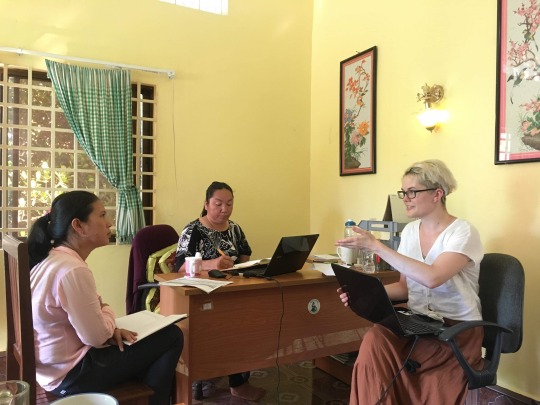
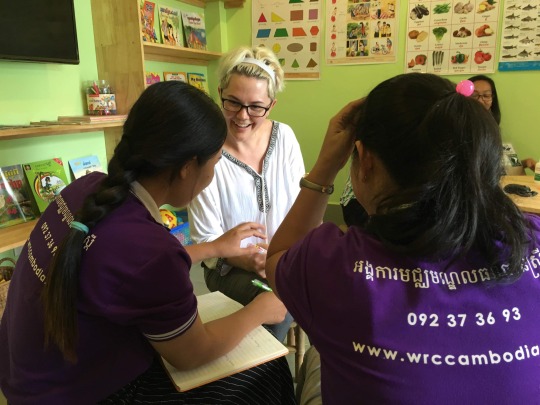
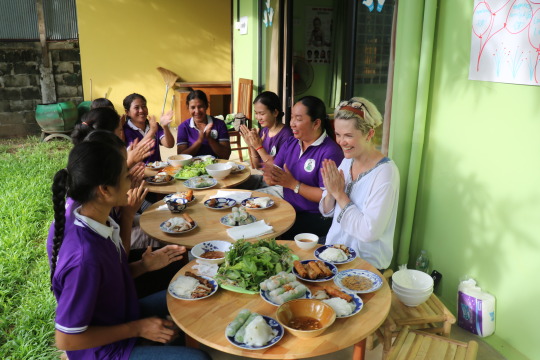
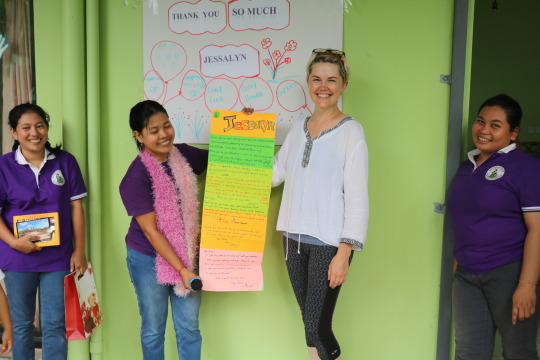
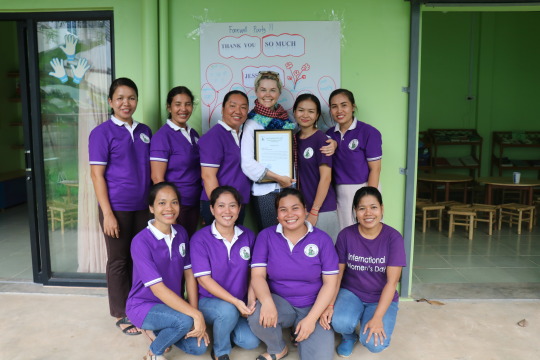
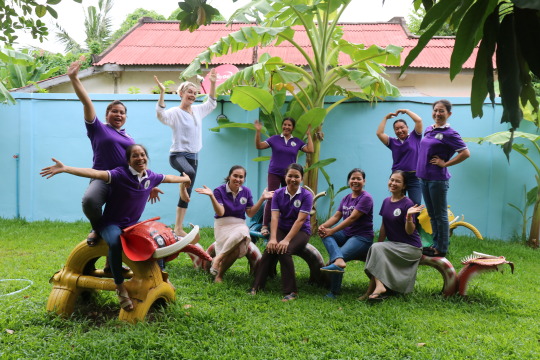
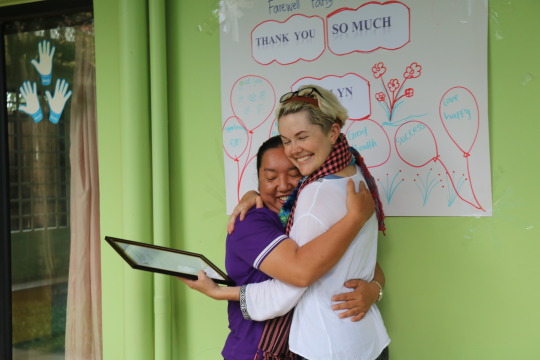
And now for the video you’ve been waiting for. A mix of karaoke and dancing, Cambodian traditional music, Cambodian dance music, and “Westerner dance music” (Eminem and Jennifer Lopez to be specific). As you can see, the ladies tried their best to teach me to dance but they concluded that while my singing skills are very good, my dancing skills leave something to be desired. Note that I am not the talented Eminem rapper this is Hannah, another volunteer with WRC who is here for one year serving WRC with communications support from an Australian volunteer organisation.
vimeo
Farewell Siem Reap!
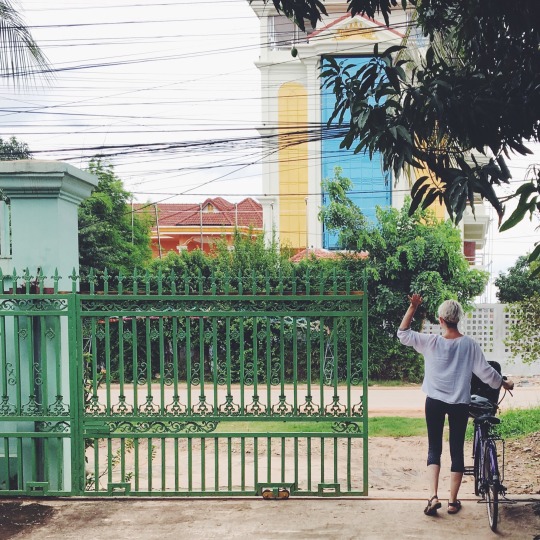
0 notes
Photo

Rebuilding an over-populated school so kids can more effectively learn skills to change their future. - Thank you @visioncambodiaorg for the work you do and the opportunity you create for anyone to significantly impact the world. - VisionCambodia.org is run by volunteers to allow 100% of donations go to helping people rather than to pay administrative salaries. - They are the future of non-profits and are making a massive impact for thousands of people. - Please look them up and learn how simple it is to get involved with donations of money or time. - - - - #motivation #inspiration #mentor #growth #mindset #businessmindset #entrepreneur #growthmindset #business #businessmotivation #health #nutrition #body #style #model #lifestyle #education #school #charity #healthyliving (at Siem Reap) https://www.instagram.com/p/BvM7geTFYCG/?utm_source=ig_tumblr_share&igshid=1w8p1orltan6o
#motivation#inspiration#mentor#growth#mindset#businessmindset#entrepreneur#growthmindset#business#businessmotivation#health#nutrition#body#style#model#lifestyle#education#school#charity#healthyliving
0 notes